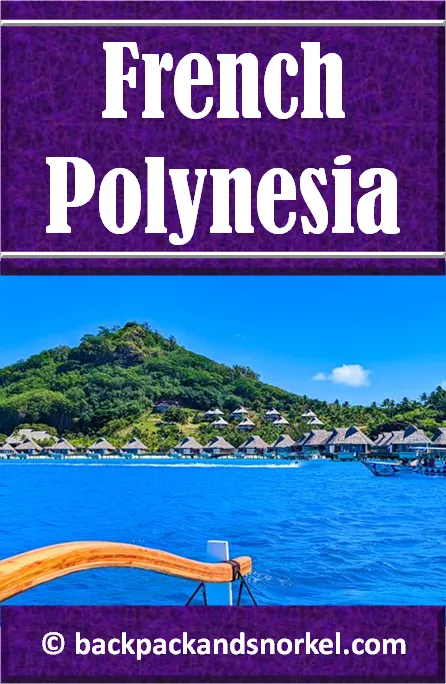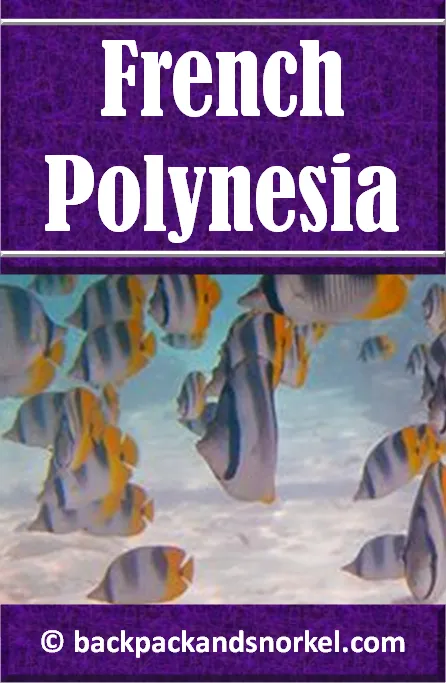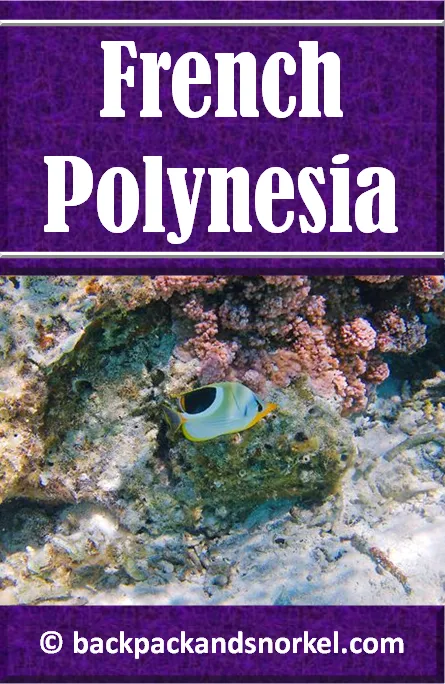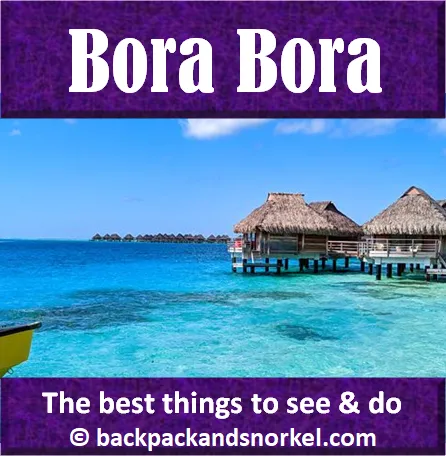Backpack and Snorkel Travel Guide for French Polynesia - French Polynesia Purple Travel Guide
This French Polynesia Travel Guide tells you what the best things to see and do are in French Polynesia. It tells you what the best beaches are and where the best snorkeling is and we show you photos of what you will see.
Why you should visit French Polynesia
Would you like to visit a country with gorgeous white or black sand beaches that you can visit year-round and that has incredibly turquoise waters with some of the best snorkeling in the South Pacific right off the beach? Would you like to experience French savoir-vivre charm and meet some of the friendliest people on the planet?
French Polynesia has all that waiting for you. So, when do you visit?


Unlike the neighboring Cook Islands, the islands of French Polynesia are usually larger and have much more rugged and towering mountains. Nevertheless, you can easily explore the islands by car or scooter and the well-developed road system.
As the population in French Polynesia is higher than that of the Cook Islands, and there are more visitors, the tourist infrastructure is typically better developed. On the other hand, you will have it more difficult finding deserted beaches. Even on busy days, we often had lots of space between us and our sunbathing beach neighbors.
Papeete in Tahiti has the only international airport in French Polynesia. Many tourists use Papeete as a jump-off point to other islands and don’t spend a whole lot of time in Tahiti. We can understand that the incredible beauty of islands like Bora Bora and Moorea get so much attention, but Tahiti is quite different and, in our opinion, definitely worth a few days of your time. In this French Polynesia Purple Travel Guide we will tell you why.
Unlike other French Polynesian islands, Tahiti shows its volcanic origins by having mostly black sand beaches and only few beaches where white sand mixes with various amounts of black sand and creates different shades of grey.
In this French Polynesia Purple Travel Guide, we will tell you what you need to know to visit Tahiti, Moorea and Bora Bora and we show you the best things to do in these islands and, of course, we show you where the best beaches and snorkeling locations are.
To help you find out what best fits you, we have added lots of photos and links to google maps locations and additional reviews.
Join us to explore the best things to see and do in French Polynesia.
Not included in this French Polynesia Purple Travel Guide are:
- the Marquesas Islands. This remote group of islands consists of rugged volcanic peaks with deep valleys and lush jungles, and does not have lagoons and extensive coral reefs like the rest of French Polynesia. Due to the remoteness of the Marquesas Islands, a cultural identity has evolved with traditions, art, and a language that differs from the rest of French Polynesia.
- Huahine Island, which is sometimes referred to as the 'Garden of Eden' due to its unspoiled natural beauty, with lush tropical landscapes, pristine beaches, and vibrant coral reefs. It provides a more authentic Polynesian atmosphere than the more popular neighboring islands. As there are fewer visitors, it is easier to find tranquility and relaxation.
We have made videos about Tahiti, Moorea and Bora Bora in French Polynesia. Please check them out.
Please see our French Polynesia Purple Travel Guide in the Backpack and Snorkel Travel Store for much more photos.
General Information about French Polynesia
French Polynesia consists of 75 inhabited and 46 uninhabited islands and atolls and has a population of almost 300,000 people. The islands and atolls are divided into 5 groups: a) Society Islands archipelago, b) Tuamotu Archipelago, c) the Gambier Islands, d) Marquesas Islands and e) Austral Islands.
As the name suggests, French Polynesia is an overseas collectivity of France and France’s only overseas country. In contrast to the Cook Islands who are in a free association with New Zealand, French Polynesia is largely dependent on France. While the local government controls primary and secondary education, environmental protection, healthcare and infrastructure, the government in France controls defense, university education, justice and security.
Driving a car or scooter in French Polynesia
Cars and scooters are driven on the right side of the road like in France and the USA. The speed limit is typically 50 km/h (31 mph) in urban areas and 60 km/h (37 mph) outside the settlements.
You are not allowed to pump your gas at gas stations. An attendant will pump the gas for you.
Air Travel in French Polynesia
The only international airport in French Polynesia is located in Papeete (airport code; PPT). You can get here on flights from France, USA, New Zealand, Japan, Chile, New Caledonia and the Cook Islands.
All inter-island flights within French Polynesia are operated by Air Tahiti. Air Tahiti use ATR and Beechcraft turbo prop machines and, at the time of writing, provided sandwiches and snack bags even on flights less than 1h.
Air Tahiti is a different company than Air Tahiti Nui. Air Tahiti Nui is a long-haul carrier which, at the time of writing, exclusively operates Boeing 787-9 aircraft for long international flights.
Inter-Island flights within French Polynesia have luggage limitations and it is not necessary to go through security, meaning that you can carry liquids greater than 100ml in your carry-on luggage. When we travelled between Papeete and Bora Bora, the carry-on limit of 5kg was not enforced.
Climate of French Polynesia
French Polynesia have warm and sunny weather all year long. May through October are considered the dry season while November through April represent the wet season. Please be advised that there is a chance of a short rain shower all-day long and during the wetter months you will typically rain showers come and go during the day, but you can also have rain that is heavy at times and that lasts for many days. The higher the mountains, the higher the chance to have clouds hang around and release their water load.
The high amount of rain and the high temperatures during that time lead to high humidity levels that can reach 100%.
The climate that you can expect during your Tahiti and Moorea visit is shown here:

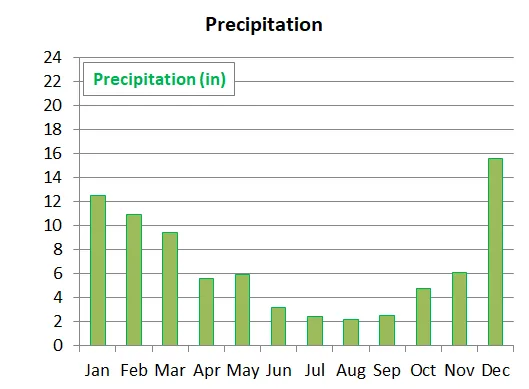
The climate that you can expect during your Bora Bora visit is shown here:
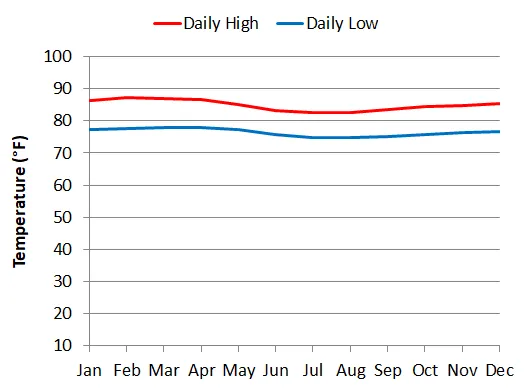
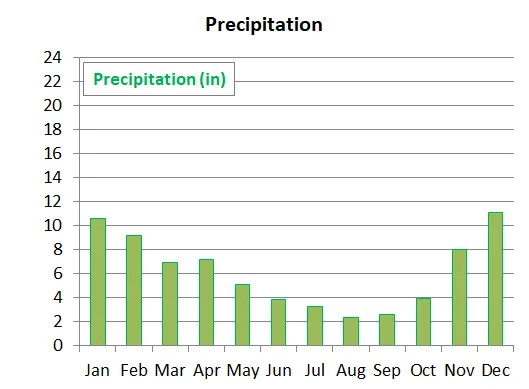
The best time to visit French Polynesia
French Polynesia has pleasantly warm and sunny weather all year long and are therefore a year-round tourist destination.
High Season in French Polynesia is during the months of July and August. This is the time of school holidays in many parts of the world, and you will find some of the best weather in French Polynesia.
Shoulder Seasons in French Polynesia are May-June and September-October. The weather is good, and school is back in session. September is often called the best month to visit.
Cyclone Season in French Polynesia is from November to April. This is the low season, and the temperatures and humidity are at their highest. Despite the increased chance of rain, there are plenty of sunny days.
Whale Watching Season in French Polynesia is from mid-August through October when humpback whales come all the way from Antarctica.
Kitesurfing Season in French Polynesia is during the trade wind season of March to August.
Snorkeling is generally good all-year long.
History of French Polynesia
The Marquesas Islands in French Polynesia were settled at around 200BC and the Society Islands incl. Tahiti were discovered and settled by Polynesians at around 300AD.
1521: Portuguese explorer Ferdinand Magellan sights the isolated Puka-Puka atoll in the Tuāmotu-Gambier archipelago
1722: Dutch Jakob Roggeveen sights Bora Bora
1767: British explorer Samuel Wallis visits Tahiti
1812: Protestant Christian conversion of Tahiti happens by the British
1834: French Catholic missionaries arrive on Tahiti, but are expulsed 2 years later
1842: France declares Tahiti and Tahuata French protectorates and Catholic missionaries begin their work to convert the locals to the Catholic church
1847: After the Franco-Tahitian war, France and England sign the Jarnac Convention that confirms France’s status over Tahiti and declares that Raiatea, Huahine and Bora Bora are to remain independent from England and France
1880: France annexes Tahiti, making it a colony
1888: France breaks the Jarnac Convention and annexes Raiatea, Huahine and Bora Bora
1889: France annexes more islands
1946: France grants citizenship to the people in what is now French Polynesia and changes the status to an overseas territory
1957: The name is changed to Polynésie Française (= French Polynesia)
1977: French Polynesia is granted partial autonomy and extended in 1984
1996: France tests a nuclear bomb at the Fangataufa atoll ending a 3-year moratorium and, after widespread protests, ends nuclear testing in French Polynesia
2003: French Polynesia becomes a full overseas collectivity of France
Language of French Polynesia
French is the only official language, but Tahitian and other Polynesian languages can be used. Due to the importance of tourism, many people speak at least some English. It is noteworthy, that the majority of tourists come the long way from France, so English will always be the second language.
The Tahitian version of Maori is different from the Maori that is spoken in the Cook Islands.
Tahitian does not have a K sound or a B sound.
As an example:
English: Hi; may you live long
Cook Islands Maori: Kia Orana
Tahitian: Ia Orana
That also means that Bora Bora’s original name was actually Pora Pora.
Money and Credit Cards in French Polynesia
The currency used in French Polynesia is the CFP franc (XPF) which has a fixed exchange rate with the euro. You can find the current exchange rate here.
Credit cards (MasterCard and VISA) are widely accepted. You will only need cash to pay street vendors, or if you make small purchases that fall under the minimum credit card threshold that vendors have – which only happened to us once.
There are ATMs on Tahiti, Moorea and Bora Bora.
Electricity in French Polynesia
Like in France, electricity is at 220V and 50Hz. Wall plugs are the same as in Europe, Types C, E and F round two plugs.

Tap water in French Polynesia
Tap water is potable in Papeete in Tahiti and it was safe to drink where we stayed outside Papeete in Tahiti, and in Moorea and Bora Bora. To be safe, always ask your hotel to confirm. Bottled water is readily available in stores.
Telephone
The country code for French Polynesia is: +689
Time in French Polynesia
The Society Islands of French Polynesia are in the same time zone as the Cook Islands and Hawaii. Daylight savings time is not observed.
You can find the current local time of the Society Islands here.
You can find the current local time of the Marquesas Islands here.
You can find the current local time of the Gambier Islands here.
Visa requirements for French Polynesia
You can check if you need a visa to enter French Polynesia here.
Wifi (WLAN)
Wifi as very fast and convenient in all three of our Airbnb’s in Tahiti. In Papeete, we had mostly good cell phone reception and data over our phone plan was good.
Wifi in Moorea and Bora Bora was slower than in Tahiti, but still good and much faster than in the Cook Islands.
What part of French Polynesia do you want to expolore now?
Author: Rudy at Backpack and Snorkel
Bio: Owner of Backpack and Snorkel Travel Guides. We create in-depth guides to help you plan unforgettable vacations around the world.
Other popular Purple Travel Guides you may be interested in:
Like this Backpack and Snorkel Purple Travel Guide? Pin these for later:
